
Coorg, Karnataka, India
04-05-2023
Coorg, Karnataka: A Tourist Destination
Coorg, also known as Kodagu, is a popular tourist destination located in the state of Karnataka, India. The region is famous for its scenic beauty, lush green hills, coffee and spice plantations, and waterfalls.
Some of the top attractions in Coorg include:
Abbey Falls:
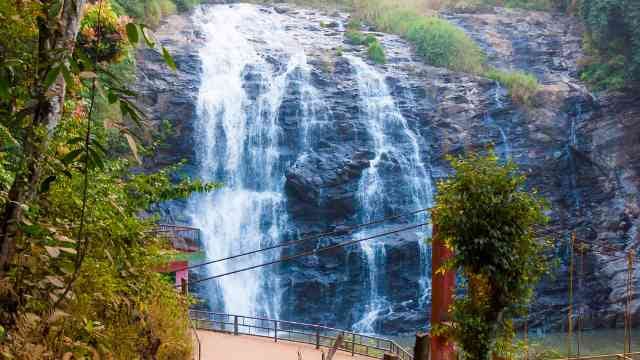
Abbey Falls is a popular tourist destination located near Madikeri. The waterfall is located in the midst of a private coffee and spice estate, and is surrounded by lush greenery, making it a scenic spot for nature lovers and photographers.
The waterfall is formed by the River Kaveri, which flows through the Western Ghats and drops from a height of around 70 feet, creating a beautiful cascade of water. The area around the falls is well-maintained and has a walkway that allows visitors to get close to the waterfall.
To reach Abbey Falls, visitors need to take a short trek through a dense forest, which is part of the coffee and spice estate. The trek is relatively easy and takes around 10-15 minutes, but visitors need to be careful while walking on the wet rocks and steps near the falls.
The best time to visit Abbey Falls is during the monsoon season (June to September), when the waterfall is at its full force and the surrounding area is lush green. However, visitors need to be cautious during this time, as the area can get slippery and dangerous. It is recommended to wear comfortable footwear and carry rain gear while visiting the falls.
Abbey Falls is a must-visit destination for nature lovers and those seeking a serene escape amidst the beauty of Coorg.
Dubare Elephant Camp:
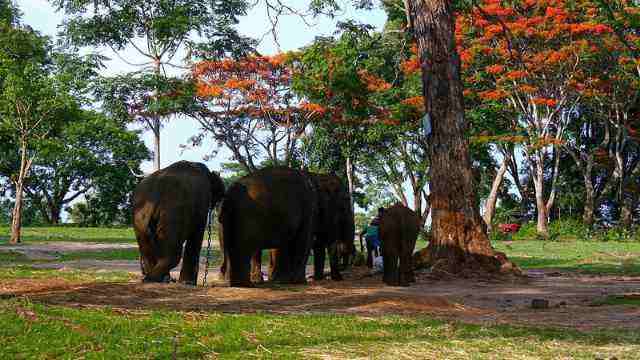
Visitors can interact with trained elephants, go on elephant rides, and even bathe them in the river.
Dubare Elephant Camp is a popular tourist attraction located near the town of Kushalnagar of Coorg. The camp is situated on the banks of the River Kaveri and is a hub for elephant training and care.
The camp was originally established as an elephant training center for the Indian Forest Department, but it has since been converted into a tourist destination, where visitors can interact with trained elephants and learn about their behavior and habitat.
At the camp, visitors can watch elephants being bathed, fed, and trained by their mahouts (handlers). Visitors can also go on elephant rides through the forest and along the river, which is a popular activity.
The camp offers several other activities such as coracle (traditional round boats) rides, trekking, and bird watching. There is also a small museum that showcases the history of the camp and the importance of elephants in Indian culture.
Dubare Elephant Camp is open throughout the year, but the best time to visit is during the winter season (October to February) when the weather is pleasant and the river is calm. Visitors are advised to wear comfortable clothing and footwear as well as carry sunscreen and insect repellent.
Dubare Elephant Camp is a great destination for animal lovers and those seeking a unique and educational experience in the midst of the beautiful Coorg district.
Talacauvery and Bhagamandala:
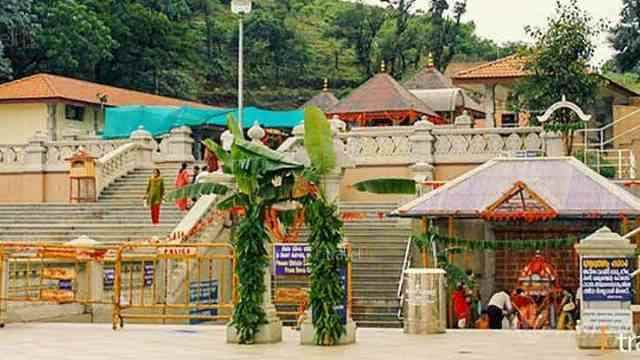
These two sacred sites are believed to be the origin of the River Cauvery, and are important pilgrimage sites for Hindus.
Talacauvery and Bhagamandala are two important pilgrimage sites located in the Coorg. Both sites are situated on the banks of the River Kaveri and are considered to be sacred by Hindus.
Talacauvery is believed to be the origin of the River Kaveri and is a popular pilgrimage site for devotees. The site is marked by a small temple dedicated to Lord Brahma, and a holy pond called the Brahma Kundike. Visitors can take a dip in the pond, which is believed to wash away sins, and offer prayers at the temple.
Bhagamandala is located a few kilometers downstream from Talacauvery and is another important pilgrimage site for Hindus. The site is marked by a temple dedicated to Lord Shiva, and a confluence of three rivers – the Kaveri, the Kannike, and the Sujyoti. The spot where the rivers converge is considered to be a sacred place and is known as Triveni Sangama.
Apart from the temples, visitors can also explore the beautiful surroundings of Talacauvery and Bhagamandala, which are surrounded by lush green hills and offer panoramic views of the Coorg district. There are also a few shops and food stalls near the temples where visitors can buy souvenirs and local snacks.
The best time to visit Talacauvery and Bhagamandala is during the winter season (October to February) when the weather is pleasant and the sites are less crowded. Visitors are advised to dress modestly and remove their footwear before entering the temples.
Talacauvery and Bhagamandala are important pilgrimage sites and offer a spiritual and scenic experience to visitors.
Namdroling Monastery:
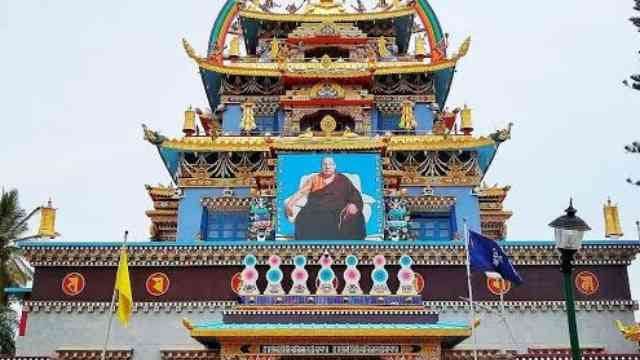
The largest Tibetan settlement in South India, this monastery is home to thousands of monks and is famous for its vibrant Buddhist culture.
Namdroling Monastery, also known as the Golden Temple, is a popular tourist destination located in Bylakuppe, a Tibetan settlement in the Coorg. The monastery is one of the largest Tibetan Buddhist centers in the world, and is home to thousands of monks and nuns.
The monastery was founded in 1963 by His Holiness Pema Norbu Rinpoche, and is renowned for its stunning architecture and intricate murals. The main prayer hall of the monastery is decorated with golden statues of Buddha and other deities, and features elaborate frescoes on the walls and ceiling.
Visitors can also witness the monks and nuns performing their daily rituals and chanting prayers in the monastery. The monastery also has a peaceful garden and a small market where visitors can buy souvenirs and traditional Tibetan handicrafts.
The best time to visit Namdroling Monastery is during the winter season (October to February) when the weather is pleasant and the monastery is less crowded. Visitors are advised to dress modestly and remove their footwear before entering the main prayer hall.
Namdroling Monastery is a must-visit destination for those interested in Tibetan Buddhism and culture. The monastery offers a unique and peaceful experience in the midst of the beautiful Coorg district
Coorg Wildlife Sanctuary:
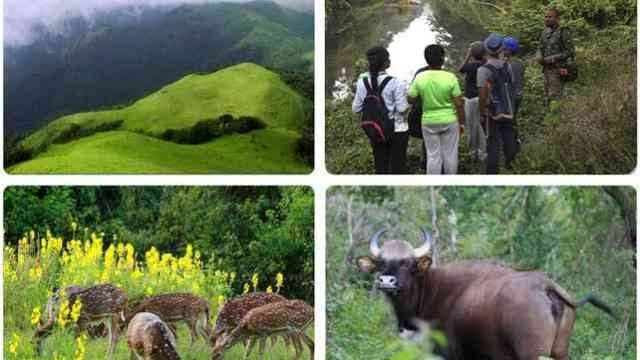
Visitors can spot a variety of animals including elephants, deer, wild boars, and langurs in this sanctuary.
Coorg Wildlife Sanctuary, also known as Pushpagiri Wildlife Sanctuary, is a protected area located in Coorg. The sanctuary is spread over an area of approximately 102 sq. km and is home to a diverse range of flora and fauna.
The sanctuary is situated in the Western Ghats and is characterized by its lush green forests, rolling hills, and sparkling streams. The sanctuary is home to several endangered and endemic species such as the Malabar giant squirrel, the Nilgiri langur, and the lion-tailed macaque.
Visitors to the sanctuary can go on guided treks and nature walks, which offer a great opportunity to spot some of the wildlife and explore the beautiful surroundings. The sanctuary also offers jeep safaris for those who want to cover more ground and see a wider range of wildlife.
Apart from the wildlife, the sanctuary also has several beautiful waterfalls and viewpoints that offer panoramic views of the Coorg district. Visitors can also explore the small villages and tribal settlements that are located within the sanctuary.
The best time to visit Coorg Wildlife Sanctuary is during the winter season (October to February) when the weather is pleasant and the wildlife is more active. Visitors are advised to wear comfortable clothing and footwear as well as carry sunscreen and insect repellent.
Coorg Wildlife Sanctuary is a great destination for nature and wildlife enthusiasts, and offers a unique and immersive experience in the midst of the beautiful Coorg district.
Coffee and Spice Plantations:
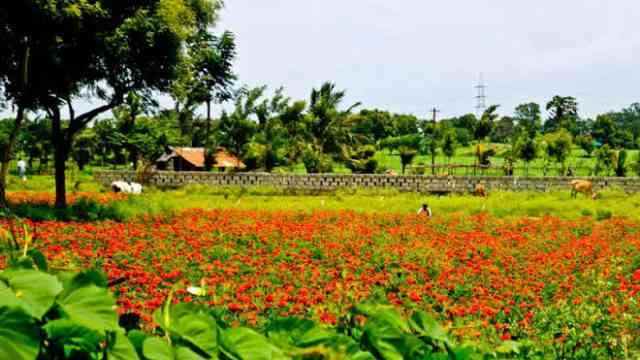
Coorg is famous for its coffee and spice plantations, which are a major attraction for tourists visiting the district. The region has a conducive climate and fertile soil, making it ideal for the cultivation of coffee, pepper, cardamom, and other spices.
Visitors to the plantations can go on guided tours, which offer a great opportunity to learn about the cultivation and processing of coffee and spices. The tours take visitors through the lush green plantations, and provide insights into the various stages of coffee and spice production, including harvesting, drying, and roasting.
Apart from the plantations, visitors can also explore the small villages and towns that are located within the plantation areas. The villages offer a glimpse into the local culture and way of life, and visitors can interact with the locals and learn about their customs and traditions.
Some of the popular coffee and spice plantations in Coorg include the Tata Coffee Plantation, the Chelavara Falls Coffee Estate, and the Mercara Gold Estate. Many of these plantations also offer homestay options, where visitors can stay in traditional Coorgi homes and experience the local hospitality and cuisine.
The best time to visit the plantations is during the monsoon season (June to September) when the plantations are lush and green, and the streams and waterfalls are at their fullest.
The coffee and spice plantations of Coorg offer a unique and immersive experience, and are a must-visit destination for those interested in agriculture, nature, and local culture.
Coorg is also known for its delicious cuisine, which includes dishes such as pandi curry (pork curry), akki roti (rice bread), and kadumbuttu (steamed rice dumplings). The best time to visit Coorg is from October to May, when the weather is pleasant and the region is at its scenic best.